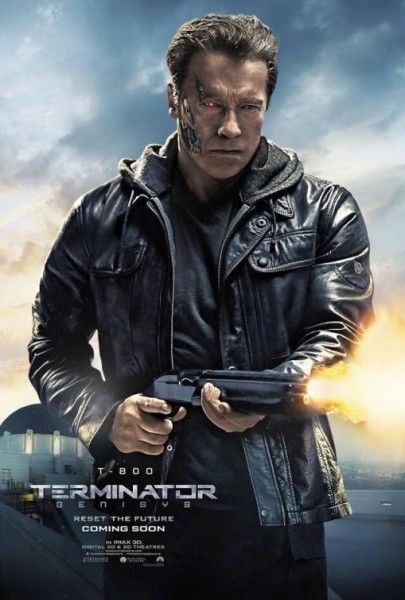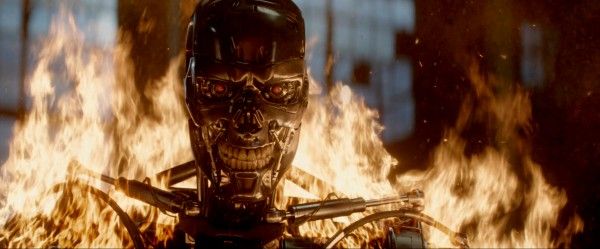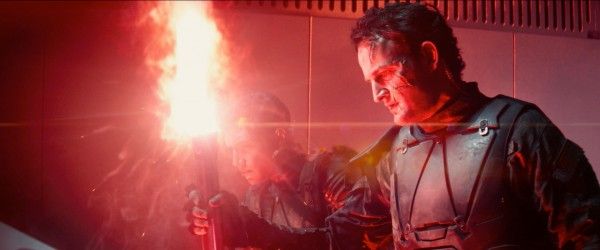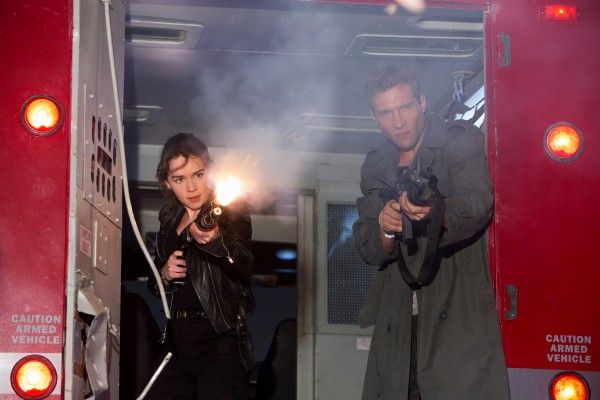Who thought the world needed Terminator Genisys, the fourth Terminator sequel to a film that never needed one? Blame IPO thinking for what amounts to a bunch of plate spinning in an attempt to create a new trilogy of Terminator films that bring back all your favorite characters through (mostly) less charismatic actors to no great results. Unfortunately Genisys was popular abroad so it’s possible we could see more of these films.
As the film begins the future war is almost over so John Connor (Jason Clarke) sends Kyle Reese (Jai Courtney) to 1984 to find and protect his mother Sarah Connor (Emila Clarke, no relation). But as he’s sent back he sees John being attacked by a terminator-esque figure (Matt Smith, who has little to do in the film), and when Kyle arrives, he’s not only anticipated by a T-1000 (Byung-Hun Lee), but by Sarah Connor herself, who pops open a car door and says “come with me if you want to live.” She’s accompanied by “Pops” (Arnold Schwarzenegger), the T-800 model that has been protecting her since she was a child and has informed her of what her future holds, which includes mating with Kyle. The two must then travel to judgement day to stop it, but Kyle has altered memories that tell him Judgement Day is no longer in 1997, but in 2017 when Genisys - a new operating system - is launched worldwide by Miles Dyson. It turns out that John Connor has traveled back in time to help develop the software, and he’s now a T-3000 (or something like that), and the three are caught in a weird time paradox as the future has been rewritten so often. Who’s to say if Sarah and Kyle will ever get together, even if they have some chemistry.
If credit is to be given to Terminator Genisys, which is mostly passable in that it’s chocked full of action that’s well staged and reasonably exciting, it’s that screenwriters Laeta Kalogridis and Patrick Lussier had few options in continuing the story other than to go back. Terminator: Salvation proved that showing the future war wasn’t all that interesting, so the only way to go forward was to navel gaze. What they came up with for a sequel is a greatest hits package of things you may have liked in the previous entries. Unfortunately, there’s no weight to anything, because – though a hard reboot may have worked for Star Trek because that was a much older franchise and could be serialized – there was never much about the original story that needed a sequel. When Cameron came back for Judgement Day, he approached it as a party picture, a chance to go bigger and play with new toys. When the third film came about, it had a chance to course correct the franchise to its original intentions: any attempt to change the past only cements the future (something slightly more apparent in the deleted scenes from the first film). With these last two films, there’s no story left to tell. Genisys may alter the timelines, but all it does is create a situation so convoluted that the most pleasure the film offers is in nitpicking the timeline (like, who sent pops to Sarah? Perhaps that’s a question meant to be answered in the sequels.)
Trying to continue a franchise by bringing back favorite characters under new but dramatically altered visages - only Kyle, the lovesick soldier, remains the same and though it’s not Courtney’s fault, he doesn’t have the urgency or desperation that made Michael Biehn’s performance so moving - you don’t get the Sarah or John Connor you want to see, you get to see the fan-fic version of them, while bringing in Schwarzenegger as an old Terminator is seemingly meant to give continuity to a thing that doesn’t really need it. Ultimately this film is a package, an idea of a movie, something that was more valuable as a saleable product than piece of art. The results are to be expected.
Paramount presents the film on Blu-ray with a DVD and Digital copy. The film is presented in widescreen (2.35:1) and in Dolby Atmos (which also plays in 5.1 and 2.0 situations). Extras are limited. The supplements start with “Family Dynamics” (16 min.), which focuses on the main cast, with Arnie getting a lot of love, and it walks through every major actor cast in the film and praises them to high heaven. “Infiltration and Termination” (25 min.) walks through the shooting locations, and offers more actors comments on how great it was to make the film. To sum it up, the film wasn’t shot in Los Angeles at all, as other parts of the country look more like 1984 LA than Los Angeles does now. “Upgrades: VFX of Terminator Genisys” (15 min.) gives the effects their due, with the main focus being on the work that went in to recreating 1984 Schwarzenegger. It is impressive as they have to deal with the uncanny valley, and their results are solid.





